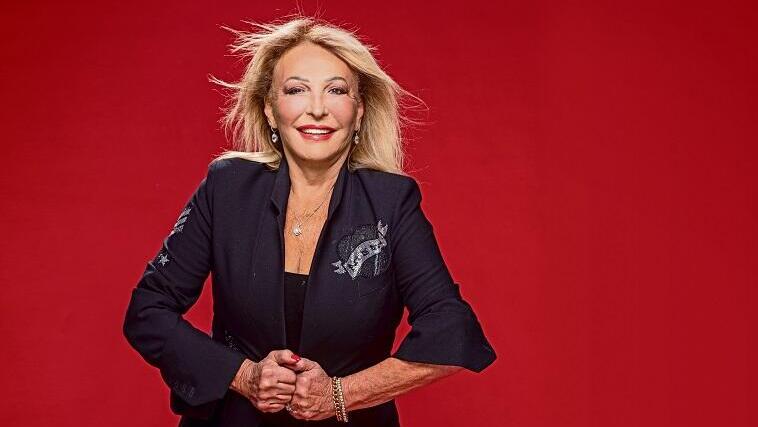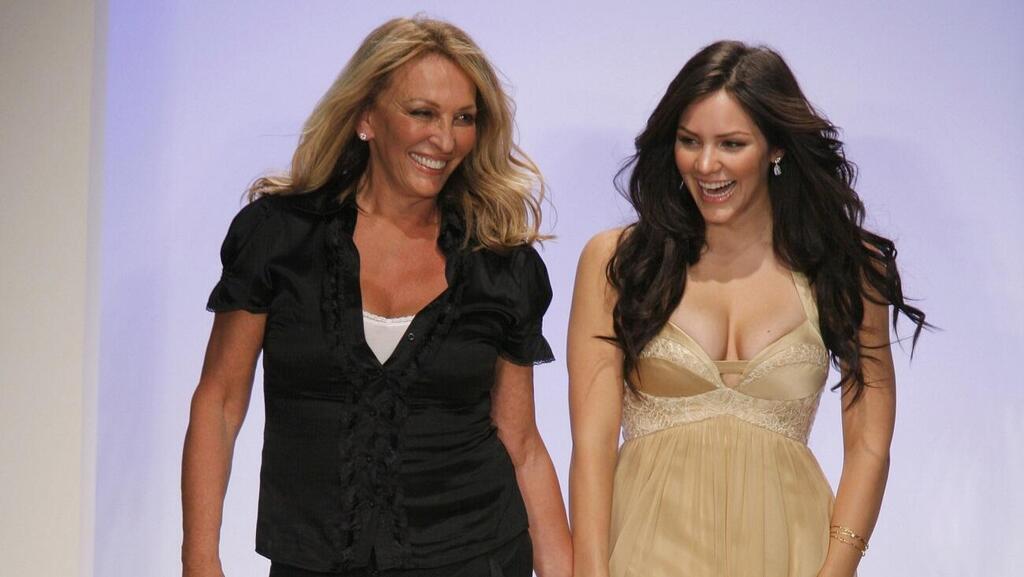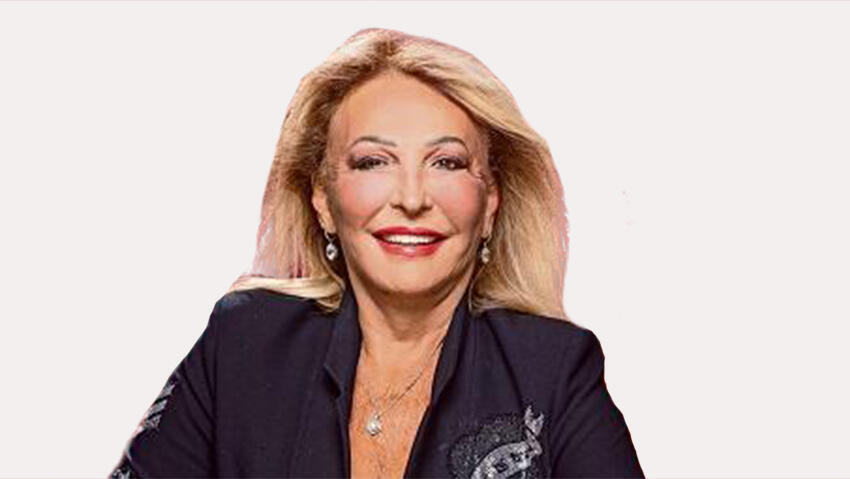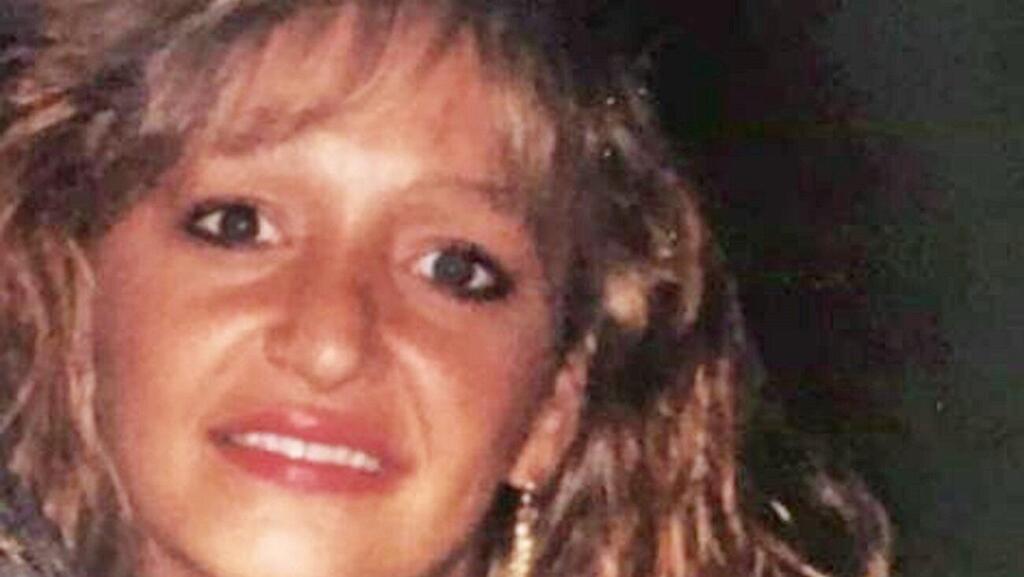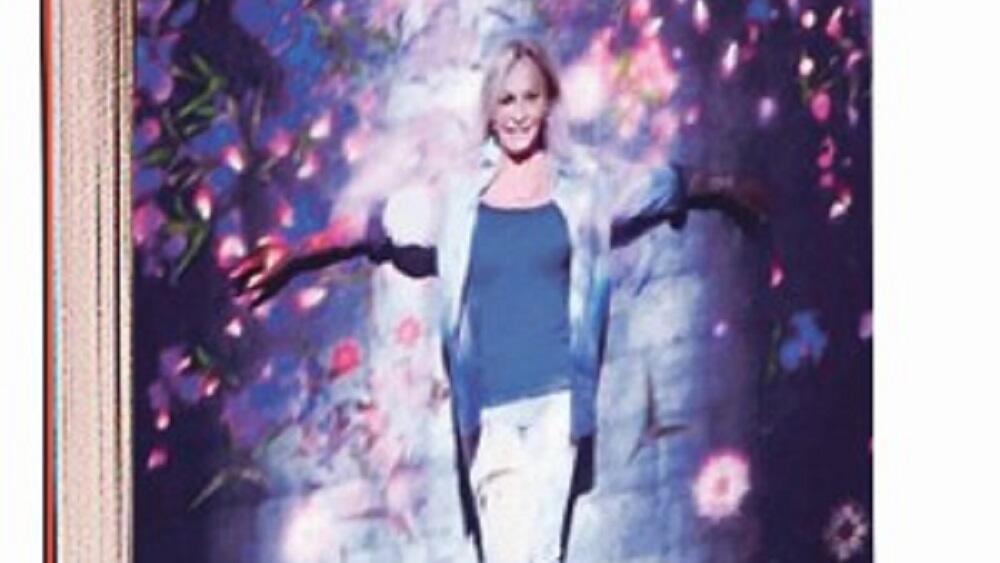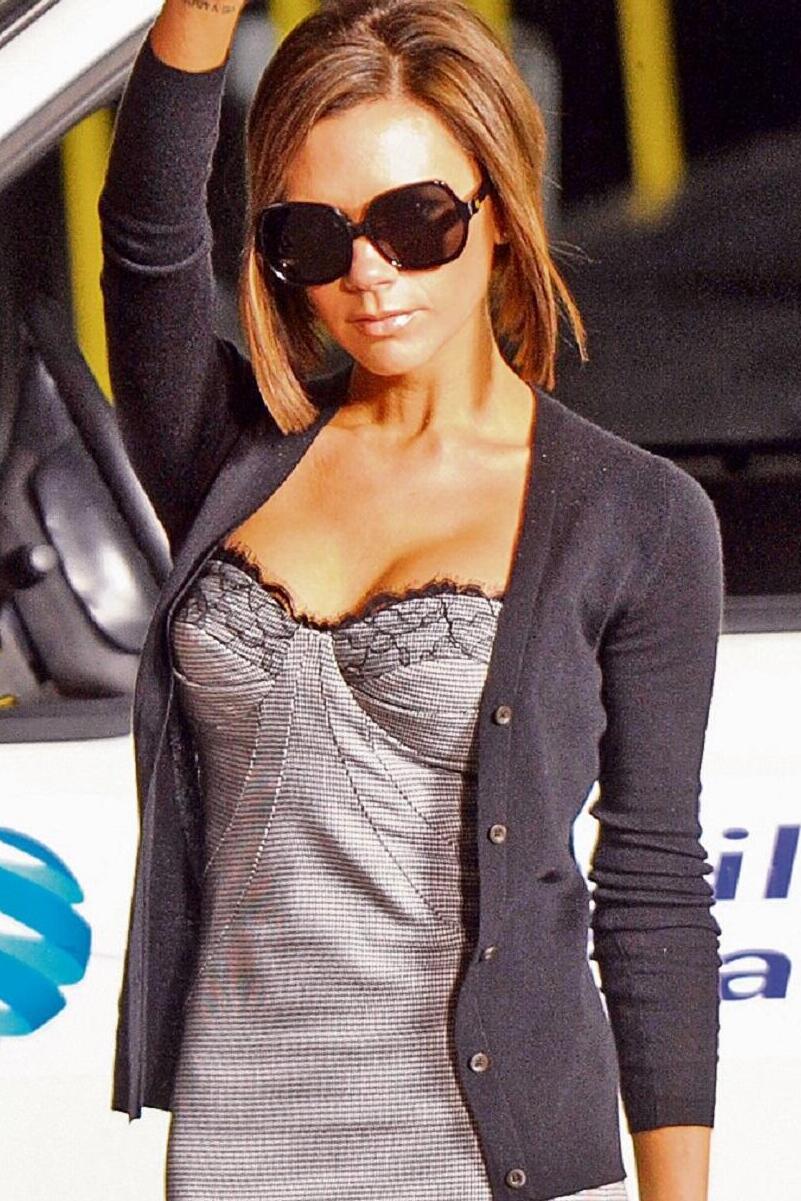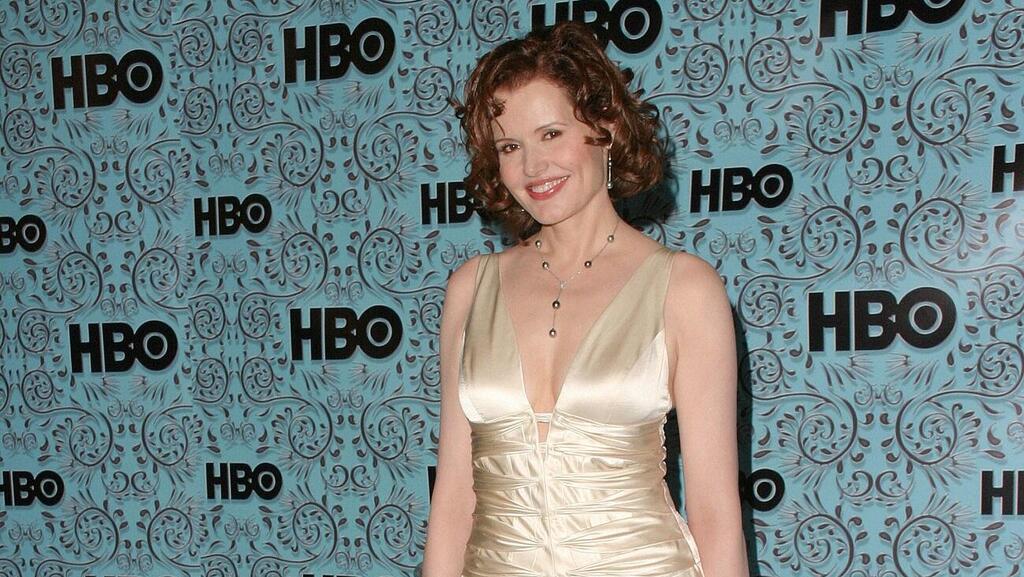Overnight, the iconic yellow dress she designed for Kate Hudson in “How to Lose a Guy in 10 Days,” put Dina Bar-El on the international fashion map. Within months, sales of the dress hit $1 million.
She should have been cracking open the champagne, but the designer, who’d made her way from Ramla to Beverly Hills, just desperately missed her one and only daughter.
"Aged just 34, I asked my rabbi why my daughter died just as she could have shared my success,” Bar-El tells Ynet. “He told me that Orna came into the world to show me the way to the top. When she’d completed her task, she left. What could I do other than accept that no one could change her?”
Bar El (“76, but way ahead of all the 22-year-olds”) has arrived in Israel with Ilan Silver, her fourth husband of 41 years for a show of her choice pieces. She brought with her that yellow dress and further items she designed for “American Idol,” “Desperate Housewives” and “Sex and the City.”
A decade ago, after winning the Women’s Couture Award (“fashion’s Emmy and Grammy rolled into one”), she decided to retire, close the factory and replicate 100 designs for her private wardrobe. She donated the hundreds of other dresses to orphanages “so that each and every girl can be a princess or a queen.”
Gorgeous selfies of herself with fashionistas including Sharon Stone, Victoria Beckham, Penélope Cruz grace the pages of her autobiography, “Design the Dream”. With heartwarming honesty, she tells her life story with all the twists and turns reminiscent of the telenovela “The Bride from Istanbul” (and yes, the Bride from Istanbul has also worn her clothes).
“The book and the show are my way of parting from Orna,” Bar-El tells us, oscillating between sadness to joy. “It was Orna who suggested I shift from sportswear to evening dresses, and carried on trying to persuade me, even when I said that dresses weren’t me.
"On a very ordinary day at the factory, not long before she died, she said to me: ‘You’ve no idea how successful you could be if you bring your imagination and creativity to haute couture.’ After she died, I saw this as her dying wish and I fulfilled it. The challenges of this new path somewhat lifted my spirits. I still hear Orna yelling at me from Heaven, ‘I told you so’. It’s a wound that will never heal.”
She was a 15-year-old hair salon apprentice when she found out she was pregnant. “I thought that was the end for me, that my life was over, that I’d be at the hair salon until my dying day. Who’d want a pregnant girl, or a girl nursing a baby washing her hair? When Orna was two years old and I could see no way out of the basement apartment in the Hatikva Neighborhood and I tried committing suicide.
"I slashed my veins. I wasn’t happy when they saved me. This is what I want to tell people who start out like me, not in a glowing place, who just can’t see the light at the end of the tunnel. If I could take responsibility for my own life, dispelling stigmas and reaching phenomenal levels of success, even by American standards – you can do it too. Don’t forget, you’re a woman!”
What do you mean?
“Why did God first create man? Eve was his second attempt. Eve is the new and improved model.”
After beating cancer for the second time, Bar-El feels she’s on a mission. “I feel God has given me my health so that I can inspire others. My book will be distributed in all the countries they sold my clothes, including the Arab states. After touring some of these countries’ red carpets, I want to enjoy life. I have a PhD in how to live well.
"I hope the book means I’ll be invited to talk in Israel. I’ve no interest in sitting around in cafés. I want to go to the periphery. I want to look into the eyes of every broken woman and tell her: 'Get up. You can do it.' My second dream is making the book into a movie or a TV series. I already know who’ll play me.”
Who?
“Gal Gadot. She’s the best and there’s no one better for my character. I started at the bottom, the very bottom, and I haven’t forgotten how it felt. Gal and her husband will also direct my life story.”
Do they know about this?
“Not yet, but we have mutual acquaintances who’ll hook us all up. I believe Gal will very much identify with my message. She’s a self-made woman. She also built herself up with sweat and blood. There’s no success without the smell of sweat.”
Dina was the first baby born in an American refugee camp in Germany at the end of World War II to Miriam and Ariyeh Kaufman. Her parents’ eyes first met in Auschwitz. (“My mother lifted a pacifier that had fallen from the mouth of a baby my father was holding. His wife and children didn’t make it out of Auschwitz.”)
They then met at a bus station in Prague. “My father recognized my mother’s turquoise eyes, and they started a new life together.”
At the age of four, she found herself in a shelter in the central Israeli city of Ramla. “My father was a proud man. He didn’t want hand-outs from the Jewish Agency, so we were sent to the shelter. When he found work as a chef, we moved into a four-bedroom Arab house – a family in each room. The bathroom was outside. Beginnings are hard.”
Unlike her father who embraced life, acclimatizing to life in Israel was difficult for her mother. Dina, their eldest child, a “second generation Holocaust survivor," severely lacked any clear expressions of warmth or love.
“In sixth grade, our class became pre-vocational: four hours of regular lessons and then four hours of sewing. Two months later, at parents’ evening, my sewing teacher said to my mother, 'Your daughter has a gift from God. She’ll be an international designer.' My mother wasn’t having it: 'My daughter’s not going to be a seamstress. She’ll be a lawyer.' I felt bad for the teacher who was complimenting me. This was the first rift between myself and my mother.
"When I was 14, I saw an advertisement in the newspaper that they were opening a school for hair stylists in Ramat Gan. I called. It cost 500 liras for a three-month course. That was two months wages for my father - I couldn’t ask my parents for that kind of money. One day, my father’s brother, Uncle Yitzhak, visited from Tel Aviv."
"I begged him to lend me 500 lira and I promised him I’d repay the loan at the end of the course. I’d get up at 5:30 every morning to take two buses – one from Ramla to the Tel Aviv Central Bus Station, and another from there to Ramat Gan. Two months later, a client came into the salon and asked me to cut her hair.
"I told her that I wasn’t allowed to cut hair, that I was still learning. She was very complimentary about what I’d done with a fellow student’s hair, so I took my chances. She was beyond pleased. When she went to pay the manager at the desk, he asked her who was responsible for her wonderful hair. She pointed at me. The manager berated me and threatened to throw me out.
"I said to him: ‘All the students here have their fees paid by the parents. I’m the only student here paying my own way and I wanted to show you that I’m prepared to work hard.’ Instead of throwing me out, he got me a job near the school.”
The manager then offered to transfer her to a salon he was opening in Netanya. “I said, ‘Why not, my soldier boyfriend is in Netanya.’ I was happy to get out of Ramla and glad to get away from my parents. When I was 15, I started vomiting. My boyfriend’s mother took me to a gynecologist in Netanya. I was pregnant. “
Was getting married the only option?
“I wanted an abortion, but his mother was afraid that I might not be able to get pregnant again if I had an abortion. So, I made the journey from Netanya to Ramla and said to my parents: ‘Mom, dad, I’m inviting you to my wedding. Oh, and you’ll be grandparents in seven months’ time.’ They were shocked. After the wedding, we moved into a one-bedroom apartment in the Salame neighborhood. Although my husband was five years older than me and was a career soldier, we couldn’t afford food.”
As she was nursing a six-month-old baby, her parents announced they were leaving for Los Angeles to live with her father’s brothers. They said: “You’ve made your bed; you lie in it.” I understood them. This was the price I now had to pay for the choices I’d made. But I couldn’t believe that my parents were abandoning me at a time I was so helpless, so physically and emotionally weak – and for a home they’d never even seen.
"My upstairs neighbor would take care of Orna when I was at the hair salon. It was the same upstairs neighbor who found me in a pool of blood on the carpet. She pointed at the baby and shouted at me, ‘Have you asked yourself what about her?’ That was the first time that I truly understood that I was a mother, and that my baby was more important than my own depression.
"My suicide attempt showed my husband how miserable I was and he agreed that I should fly to America to be with my parents for three months, on condition that they covered all the costs.“
And after three months, did you come back to the basement apartment in Hatikva?
“No. It took only three days for me to realize that I didn’t want to come back. I got a job washing and cutting hair. I started earning good money. Within a year, I was riding around in a Rolls Royce. Orna was at a wonderful kindergarten and I was living the American dream. Then, at 4:00am one night, Interpol came knocking at the door.
"An Israeli court had ruled that I had abducted a minor and they had been sent to take her back to Israel. ‘If you don’t take her back, you’ll go to jail.’ I had three days to decide and I decided that nothing would separate us. I returned to Israel and got off the plane with my little girl."
"My husband was waiting for me at the foot of the stairs with a stay of exit order and he took us to his sister’s small apartment in Lod. The next morning, I got up and went to Tel Aviv to my uncle Yitzhak, who took me to see a lawyer. He whispered in my ear, 'I’m telling you what I’d tell my own daughter: Take your husband to America. If Delila could control Samson, you can do it too, you’re a woman. You have the tools.’ So, I started, bit by bit, talking to him about America, land of opportunity, and how our lives would be better there.“
Aided by the dollars from America (“my mother sold all the property I left behind”), they moved to a neighborhood for career army personnel in Neot Rachel in Holon.
“I worked non-stop. Six days a week in the mall and on Shabbat, I washed people’s hair on the balcony. I kept pushing America on my husband. I didn’t give up. Eventually he gave in and left the army. When he’d complain that he didn’t know any English, I’d say ‘It’s okay, neither do I.’ We got to America when Orna was eight.
"My parents moved into an apartment and gave us full use of their house, including the Mustang in the driveway. I managed my father’s restaurant, ‘Café Tel Aviv.’ My husband quickly broke, announcing “this isn’t for me. This isn’t my country. I’m going back to the army.’ Six months later, he returned to Israel, not before signing divorce papers. That was it. The saga was over. Nine stupid years had come to an end. I was 24, divorced and I wasn’t looking back. But Orna asked why her father had also divorced her. I felt her pain.“
Husband number two was Zion Bar-El, an electronic engineer from Tiberias. He was 29 and single. “He loved Orna. He’d sit with her, helping her with her homework in our New Jersey home. He taught her how to ride a bike and she started calling him ‘daddy.’ Eight months into the relationship, we got married.
"If it were up to me, we wouldn’t have got married. I was still scarred from my first husband. But Zion wanted to tie the knot. I sewed myself a unique wedding dress with white shorts a lace top. It was sexy and very flattering. I felt like one of the flower children. Zion’s mother was outraged, protesting it was inappropriate to set foot in a synagogue dressed like that.”
Married life was comfortable and cozy - until Zion started pressuring her to have child. She refused. She had bad memories of her difficult childbirth. And, she was taking care of her father who was dying of cancer. He pled with her: “Zion wants children. Let him go and you, don’t give up on the dream of being a fashion designer that you’ve had since you were 11.“ And that’s what happened.
She was a 28-year-old, twice-divorced single mother with no alimony. “I’d take Orna to school and then go to a job in the finance department of an Italian bank. I’d model in a boutique twice a week. I’d imagine I was dressing models who’d totter around in their stilettos, modeling my designs.”
Meanwhile, Craig Allens, a real estate dealer, seven years her junior courted her with furs and diamonds. She made it clear, “I’m not for sale.” When he promised to make all her dreams come true, she designed a hippy-style leather top with beads and feathers. He invested a quarter of a million dollars and rented her a place to work in downtown LA.
“Boom. It was dynamite.” The top became a kind of uniform in all city’s trendiest night clubs. She sold at over a million dollars out of the factory. She got to keep all the profits. Craig refused his share of the profits until she agreed to marry him and become the mother of his children. “I felt we just weren’t from the same place. He had been raised with a silver spoon in his mouth and I was from Ramla.”
Weren’t you afraid of being alone?
“I have no fear.”
She describes husband number three, New York leather clothing designer Ilan Levy, as exceptionally charming. She divorced him after just one month when she discovered that he already had a wife and two children. She put all his personal belongings outside her home and changed the locks. “It was a great love that vanished in a moment. I felt so stupid.”
Only six months after starting out in fashion design, she was on top of the world. Her brand, “Dina’s Creations,” grew as she specialized in leather and suede. Her best-seller was a dress with a built-in bra, made of 38 pieces of material.
“Everyone tried to copy me. I never sued. Why? I just didn’t have time for lawsuits. I was working around the clock to meet up with the incoming orders. I was also sure that no one could truly copy my work. I never designed on paper. That’s boring. I had a mannequin in my office. Every morning, I’d throw another piece of material over it. Only I know how they all fitted together.”
She was offered a very attractive deal: Businesspeople would buy 50% of the company, not including the name. They would double production by setting up their own factories in South Korea. She took the offer. This proved to be her downfall.
“I handed over to them everything I had,” she tells us. “The machines, the staff, the designs, the new collection and my client list. They stole everything and left me with nothing. It was daylight robbery. I was left without a business, without a factory and with no money. I learned the hard way that talent isn’t enough.
"You have to understand business. Craig found me new partners. It didn’t work out with them either. Orna, who wasn’t just my daughter, she was my best friend, said to me: ‘Mom, they stole from you. They hurt you. But no one can take your talent from you.’ I realized that no matter how many times you fall, what’s important is your ability to get up, hold your head up high and re-invent yourself.”
What did you do?
"I couldn’t afford to buy leather, so I bought simple T-shirts and sweatshirts. I cut out the sleeves and necklines and created a comfortable, breezy look. I sat in my living room, embroidering onto them in every color. I also added studs and rhinestones. Each piece was unique. Just like at the beginning, I went to all the best boutiques collecting orders. When the chains started placing orders, I hired a seamstress and my living room became a sewing workshop.”
She met husband number four while flying to a carnival in Brazil. A friend told her about a divorced, father of two ex-Israeli who was also flying to Rio. “We flew there. We came back. We haven’t parted since. Ilan saw my potential as a designer and accepted that, for me, work would take priority over a relationship. It was a sensible love story.
"No riddles. I bought material and created a collection of tops decorated with shiny stones. After meteoric success in New York, my accountant called me into his office to suggest we rethink our investment portfolio. I bought a home in Beverly Hills."
"Ilan agreed to let me knock it down and we invested huge sums in building the neighborhood’s most beautiful modern home. Ilan oversaw construction while I designed and sold. I needed a lot of money to send Orna to rehab. In high school, she fell in with a weed dealer. When the police did a surprise raid on our house, they found a marijuana plant growing on a window sill. We were all arrested and taken away in handcuffs.”
Eight years after Orna’s rehab, Bar-El underwent kidney surgery to remove a cancerous tumor. In the hospital, Orna whispered in her mother’s her ear: “I won’t live a single day without you. I won’t live one day in a world without you. If you’re going to die, I’ll die before you.”
Bar-El recovered, but then Orna started taking painkillers for toothache. She stepped up the dosage and became addicted once again. In August 1997, Orna tried speed - a strong central nervous system stimulant drug - in New York. "Friends managed to convince me that Orna was a big girl and I had to trust her," Bar-El says.
When she returned to LA, she discovered that Orna wasn’t at the factory. She filled out a missing person’s report at the police station. “My heart told me that a tragedy had occurred. But I didn’t want to believe my strong instincts. The police found her body in a bad neighborhood in the city. It was such an unnecessary death. Incomprehensible. Orna was so afraid of losing me, but in the end, I lost her.“
To this day, she’s sure that Orna wasn’t trying to commit suicide, but that she was “murdered in cold blood by awful people, drug dealers. Why didn’t I go to war with the people who murdered her? Because I knew it wouldn’t bring her back and I knew it would be a losing battle that would only destroy my life even more.
"The private investigator who helped us find the apartment where her body was found next to her dog, Sunshine, advised us not to get involved such terrible people. The man I suspect murdered her died shortly afterward. I chose to put it all behind me. I went back to work the day after the Shiva. She was the springboard to my success. What lifted out of my mourning was my desire to fulfill Orna’s ‘will’ and start a career designing evening gowns.
Paris Hilton, then 18, was the first model for Bar-Els’s short silk dresses with Swarovski stones. LA fashion photographer, Tal Carasso, had promised me a surprise and Paris was the surprise. I’d prepared a set for the photo-shoot, but Tal covered the bed with red satin that made the black dresses more prominent. It was genius “
On her morning walk with Orna’s dog, Sunshine, Bar-El met movie producer, Robert Evans, who holds no less than 144 Oscar nominations. He suggested she design a dress for Kate Hudson for a new film she was shooting. She also adopted a sentence from him that has accompanied her throughout her career: “Believe the impossible is possible.”
After the “yellow dress,” Hollywood opened its doors to Dina Bar-El’s brand. She appeared on all the talk shows and Sharon Stone, who attended one of her fashion shows, told her about her sister, Kelly, who is a successful Hollywood PR agent. They signed a contract and the younger Stone dressed all five “Desperate Housewives” actresses in Bar-El’s black cocktail dresses, and made sure they’d be lying on red apples.
Dina was invited to the home of Victoria Beckham (“I only realized they were my neighbors when I got the invitation. We live on the same street”). Ms. Beckham came downstairs dressed in a kimono. She asked what I had for her. I showed her my favorite dress. She dropped the kimono and was standing there stark naked. After trying on the dress that looked like it had been tailored especially for her, she refused to try on anything else.”
She was invited to put on a charity at Hugh Heffner’s Playboy Mansion. After five years of fashion shows in LA TV studios, she was awarded the 2012 Women’s Couture Award. She then decided to leave the stage. “I left like a diva,” she coos. “You have to quit when you’re at the top of your game, not when you’re on your way down. I left no debts and I left with my good name. “
11 View gallery


Kate Hudson wearing Bar-El's dress on the poster for How to Lose a Guy in 10 Days
(Photo: AFP)
What do you mean by your good name?
“Ah…. My dresses aren’t made by cutting a piece of material in half. My dresses are made of pieces of material cut diagonally. They stretch on the body. I don’t know where I picked up the technique, but it’s exclusively mine. I now have a flash drive with all the designs – over 1000, and if I’m ever short of money, I can sell the brand for a lot of money. Not a lot, a huge amount. I deserve it. I’ve worked very hard for it.”
Why should you be short of money?
“Trump led America to unprecedented economic success. But the party’s over and saving is now the trend all over the world is. I’m all for buying second hand boutique clothing.“
What has success done to you?
“I got rich. My haute couture dresses sell for $1000 - $3000. They say I’m a millionaire. I see myself as a millionaire in Netanya. In every interview I give – and there isn’t a magazine or a show that hasn’t interviewed me – I always say I’m Israeli. But I’ve never felt the need to open a shop in Tel Aviv. There’s no shortage of rich Israeli women who get themselves to Beverly Hills twice a month and stuff their suitcases full. At the peak of my career, I gave a concession to ‘Nooshka’ at Kikar Hamedina in Tel Aviv. Whenever I’d come to visit, we were delighted to see the window full of my dresses.“
You say “we” were delighted – in the plural
Yes, Ilan is an inseparable part of my success. He’s truly my partner. We’ve now retired and we’re living the life of a young couple. We travel the world. We sail. We enjoy ourselves. We’ve been together for 41 years, and for good reason. He not only looks like Clark Gable, he’s a real man. His self-confidence means he lets the woman take the lead. I never stop getting emotional with Ilan Silver. He knows who I am and what I am.”
Who are you?
"Until the age of 27, I was called Etti. I knew that I’d been named after my maternal grandmother, Ester. I found out the truth about myself as I was caring for my dying father. In his final moments, he opened his eyes, I clasped his hand and asked him ‘Daddy, do you recognize me? It’s me, Etti, your daughter.’
"And then, in a surrealistic scene, my father turned to me and said in a very clear voice: ‘You’re Dina. Your name is Dina. You’re named after my mother who was a fashion designer in Czechoslovakia before the war. That’s how you were registered. Please go back to the name you were born with. Fortune will be kind to you with the name Dina.’
"He then took his last breath. From that day, I haven’t turned around and haven’t responded when addressed as Etti. I’m Dina, for better, for worse, until the day I go to Heaven. Don’t you think Gal Gadot and I have similar eyes?“


